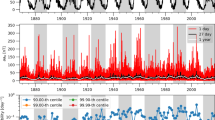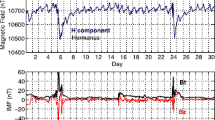Summary
The Atmospheric Electric Agitation is a characteristic phenomenon of the meteorological influences on the atmospheric electrical behavior. It can be explained chiefly by variations in the space charge configuration caused by turbulence in connection with the content of condensation nuclei in the air.
It is known thatall geophysical elements undergo permanently regular and irregular variations. The periods of these variations are extended from secular dimensions to short-time fluctuations. In this range the variations between about one minute and one hour are of special interest because they are caused by atmospheric turbulence. We know, e.g., the noise of the temperature, the oscillations of the air pressure, the fluctuations of the humidity and others — and we find the corresponding phenomena in the atmospheric electrical elements. We call them the «Atmospheric Electric Agitation».
As shown in detail in the paper which is in the press the examination of this agitation leads to the following results:
Considering the origin of the atmospheric electric agitation firstly it will be seen that every meteorological process shows itself so to speak in a corresponding agitation effect: It became clear, e.g., a long time ago that frontal zones and inversions — occuring without precipitation and fog (only such cases are considered here) — cause a strong agitation of the atmospheric electrical elements. Further typical causes are variations of the cloudiness, changes of the velocity and the direction of the wind, sudden decreases or increases of the visibility and other ones. But it is remarkable that on undisturbed and cloudless days the agitation is strongly marked too.
The fluctuations of the atmospheric electrical field and the current density can be explained by variations of the space charge distribution in the neighbourhood of the station, caused by the effects mentioned above. On undisturbed days these variations of the space charge distribution can be caused only by a mechanism which is connected with atmospheric turbulence:
Air masses of different origin make it possible in various respects to characterize and differentiate between various atmospheric electrical effects. The most significant of all is the aerosol content, which under the same ionizing conditions leads to a different conductivity and thereby to a different space charge configuration with its own typical behaviour.
If one carries these reactions to the small and minute air-masses which are formed by the atmospheric turbulence, then the agitation of the current and the field should be understood as caused by passing of turbulence cells, which due to their different aerosol content have different conductivities. The various space charges produced thereby give rise to the changes in field and current at the station.
This leads to the conclusion that the observations on atmospheric electric agitation indicate again the close relation between meteorological and atmospheric electrical phenomena, which are coupled particularly by the condensation nuclei as connecting link [H. Israël:Condensation nuclei as connecting link for meteorological-electrical relations. Techn. Note No. 1 and 11 of Contract 61 (514)-640]. On the other hand they lead us closer to the idea that we can use this relation obtained from the agitation as much in meteorology as in atmospheric electricity:
-
1)
The first task is to investigate the exchange process in the light of the experiences gained in work on atmospheric electricity.
-
2)
In the field of atmospheric electricity a study of the agitation looks very promising as a help in the important problem of separation of global and local influences.
-
3)
As many local influences are to be seen in the agitation, it is suggested that one looks for a correlation between these factors and the degree of the agitation of potential gradient and air-earth current density.
Similar content being viewed by others
Author information
Authors and Affiliations
Additional information
For a complete representation see:H. Israël,The atmospheric electric agitation. Quart. Journ. R. Met. Soc. (in press).
Rights and permissions
About this article
Cite this article
Israël, H. The atmospheric electric agitation and its origin. Geofisica Pura e Applicata 42, 140–142 (1959). https://doi.org/10.1007/BF02113402
Issue Date:
DOI: https://doi.org/10.1007/BF02113402




